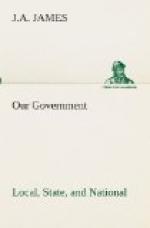Kinds. Amounts in circulation, Nov. 1, 1910. 1. United States notes $341,000,000 2. Gold certificates 836,000,000 3. Silver certificates 483,000,000 4. National bank notes 706,000,000 5. Treasury notes of 1890 3,500,000
The History of United States Notes.—United States notes, or “greenbacks,” as they are commonly called, originated during the Civil War. When the government was without specie (i.e., gold and silver money) with which to purchase supplies for the army and pay other expenses, it issued these notes. Each note says on its face, “The United States will pay to bearer $——.” Since no time was set for the fulfillment of this promise, and since there was neither gold nor silver in the Treasury with which to redeem the notes, people would naturally hesitate to accept them in payment for goods or salaries. Consequently, Congress made the notes “legal tender";[28] that is, the law compelled creditors to receive this kind of money in payment for debts. The notes passed into circulation, therefore, because people were forced to take them; but their value depreciated greatly during the war. In 1879 the government began the redemption of the notes in specie, and since that time they have been worth their face value.
[Footnote 28: Our full legal-tender coins at present are the gold coins, silver dollars, United States notes, and Treasury notes of 1890. Subsidiary silver coins are legal tender in amounts not greater than $10.00, and the minor coins are legal tender to the amount of twenty-five cents.]
Gold and Silver Certificates.—It is much more convenient to handle paper money than coins. When a person deposits gold or silver coin in the Treasury, he may receive these certificates in exchange. Consequently, the value of these certificates in circulation represents an equal amount of gold coin and silver dollars stored in the United States Treasury and ready for exchange for the certificates at any time.
National Bank Notes.—The fourth kind of paper money is issued by National banks. These are organized under United States law and subject to control by an officer of the Treasury Department. Like banks that are organized under State law, National banks conduct the ordinary banking operations. That is, they receive deposits, loan money, and buy and sell drafts in the ordinary course of business. In addition, these banks are given the right “to issue notes.” In doing this, the bank first buys on the market a certain amount of United States bonds; these it sends to the Treasury at Washington and leaves there on deposit. The bank will then receive from the Treasury “National bank notes” equal in amount to the face value of the bonds deposited. These notes say that “The National Bank of —— will pay the bearer $——, on demand.” Now, the bank may fail, i.e., it may not be able to pay what it owes to its depositors and other creditors. But the holders of National bank notes will not suffer loss. For the Treasury will sell the bonds and thus obtain cash with which it can redeem the notes held by individuals.




